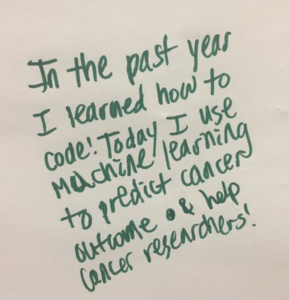Attracting more women into the Tech industry – a matter of communication and role models? (Kamila Stępniowska, May 2016)
How do we attract more women into the Tech industry? Kamila Stępniowska, co-creator of Geek Girls Carrots and workshop manager of global machine learning at deepsense.io, points out some solutions based on communication and role models.
The May theme of Crastina is ”working for equality together”.
 No one will deny facts—right? In the very beginning of my adventure with women focused tech organizations, I had an idea that the best way of creating real change would be showing problems, using statistics, research analysis and data.
No one will deny facts—right? In the very beginning of my adventure with women focused tech organizations, I had an idea that the best way of creating real change would be showing problems, using statistics, research analysis and data.
Oh, how wrong I was!
Now, from my experience—as well as studies—I know that this method doesn’t work. Not for decision makers, not for present and future women in Tech industry.
You see, publicly pointing out a problem, without providing a solution, makes you part of the problem. No one is listening to “Grouchy Smurf”! What’s even worse, players involved in the problem can defend themselves by denying that the problem even exists. If there is a “victim”, there has to be a “torturer”. And if they are a part of a problem, they don’t want to call themselves “torturer”.
It will certainly not help women in Tech either. They become a victim and a person who needs someone’s help. Someone dependent, who can not handle things on her own.
So where we can find the solution?
- Building a space to share an experience
By building communicative spaces – physical or on the internet – we can help both aspiring and experienced tech people share their personal stories and knowledge. An example is the public whiteboard used at a conference organized by Women Who Code where the participants could write about their own success in Tech or about people who they support, or had been supported by. (#applaudeHer #applaudeHim). - Expose role models
We all use and need role models. It’s not only about kids or young adults. When you are doing something for a very first time or just thinking about starting – it’s good to see how it was done before. You can learn from experience and from the knowledge of others. In a bigger picture its creation and exposure of role models. People who, in some aspects, we would like to “become” and achieve what they have achieved.
In order to create the cultural change, we must build strong, visible role models through social and mass media. Sheryl Sandberg (Facebook), Ursula Burns (Xerox), Nandini Ramani (Twitter) are excellent examples. At the same time effective role models are very often our co-workers, teachers, community or family members. People who are with us every day. We can also be role models and mentors for others. - Call to action – mentoring
Conversation about attracting more women in tech is a conversation about attitudes – with cognitive, affective and behavioural component. Sharing storiesthat convince people that they “can” is very important but it’s not enough. Further action is needed.
One of an example of a call to action could be a hack night – informal meetings to work on variety of personal, programing projects organized by different communities and organizations. One of my favorites is hack night organized by PyLadies. You can come with your laptop, learn from others, and even teach others what you know.. It’s equal – you contribute and benefit from a community in the same time.
Another example could be mentoring program Tech Leaders, organized by Women in Technology. Every other Thursday, as a mentor in this particular program, I have the oppotunity to advise and share my knowledge and experience with my mentee. She happened to be in very similar position as I was only a couple years ago when I started my very first startup (Taagshirts). I can not only provide her professional knowledge but can also empathize with her entrepreneurships dilemmas.
Looking back, it’s so clear that I have been blessed with contribution and knowledge from mentors – where and how to find information, which business models has a higher chance tosuceeed, and how to communicate my product to the market. It was so easy to find someone with more experience and was willing to dedicate a time people to brainstorm with. Many of this mentors are my good friends now. Some of them benefit from my current knowledge and experience – pay it forward.
Kamila Stępniowska is engaged in Women Who Code, SheWorx , She’s Coding, Women in Technology, and occasionally Geek Girls Carrots – a global organization for women in Tech (+ 20,000 members & 33 chapters on 5 continents) which she co-created. Currently she is also running international machine learning corporate workshops program (part of deepsense.io).
Linkedin: https://www.linkedin.com/in/kamilastepniowska
Twitter: https://twitter.com/kstepniowska

During wwConnect2016 – the conference organized by Women Who Code (February 2016), each of a participant had a chance to write on the white board about their own success in Tech or about people who they support, or had been supported by. All stories have were Tech education and career path related (#applaudeHer #applaudeHim). The idea of #applaudeHer #applaudeHim wall is a good example of communication which support diversity. On the wall you was able to see solutions – how to be part of a change – and the result – success.
- Claire Price of Crastina receives outreach award from Royal Society of Biology - October 25, 2020
- Agile Science student project at Brussels Engineering School ECAM: “We can’t wait to try it again!” - August 28, 2020
- Create an infographic in the Lifeology SciArt Infographic Challenge - June 16, 2020
- Adam Ruben – The scientist that teaches undergraduate students comedy - March 27, 2020
- Sam Gregson, Bad Boy of Science: “Comedy helps to bridge the gap” - March 10, 2020
- The Coolest Science Merchandise of 2019 - December 16, 2019
- Science Media Centre (UK) offers guide on dealing with online harassment in academia - November 26, 2019
- Agile project management taught to students and researchers at Karolinska Institutet - September 20, 2019
- Stefan Jansson: Improve your credibility! (Crastina Column, September 2019) - September 6, 2019
- The People’s Poet: Silke Kramprich, tech communicator - August 31, 2019





Leave a Reply
Want to join the discussion?Feel free to contribute!